Interferometry: INFER - Neutron Interferometric Microscopy of Small Forces and Hierarchical Structures
Summary
INFER is an ongoing project that was launched by the NIST Innovations in Measurement Science (IMS) program. INFER seeks to develop far field neutron interferometers to create multi-scale images (“3D SANS”) and perform precision measurements of fundamental constants and beyond standard model physics.
Description
Multi-scale Images and Hierarchical Structures
One of the keys identified by the 2015 DOE report, “Challenges at the Frontiers of Matter and Energy: Transformative Opportunities for Discovery Science” are methods that can study hierarchical systems. Such systems include the propagation of degradation in concrete, fluid transport in geology, ion mobility in battery and fuel cell electrodes, macromolecule transport for drug delivery, and structural biology to improve implants. What these hierarchical systems share in common is that the system function depends on the interplay of the structure across many length scales, for instance the distribution of nanoporosity over centimeter fracture surfaces influence the amount of natural gas recovered in unconventional reservoirs. It is this breadth of length scales – geological systems have pores that range from the nm to the km – presents extreme challenges to characterizing hierarchical systems within a single measurement. Creating tools that can do so are a transformative opportunity, and one that INFER seeks to realize.
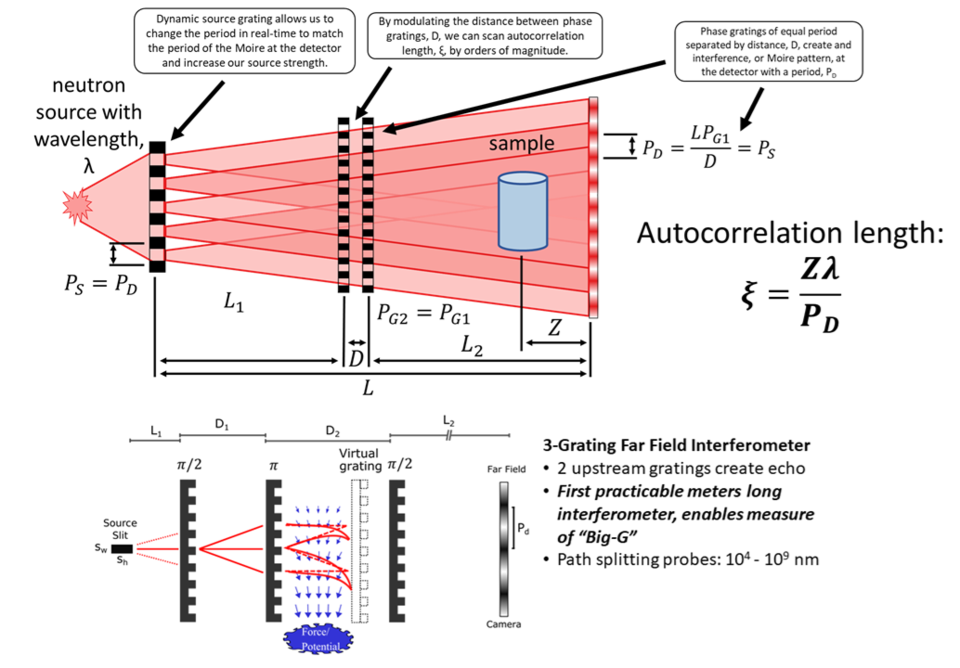
INFER forms multiscale images by performing phase imaging with a two grating far field neutron interferometer. For INFER, the enabling property of the far field interferometer is that the period of the interference pattern, P, can be easily varied by changing the relative spacing of the two phase gratings, P = L / (F D), where L is the length of the interferometer, F is the frequency of the phase gratings and D is the separation between the two gratings. Typical values are L = 5 m, F = 0.5 µm-1 and D = 10 mm, P = 1 mm. An important property of a grating interferometer is the autocorrelation length, ξ, which is determined by ξ = λ Z / P, with λ the neutron wavelength and Z the separation of the sample and detector. As an example, for λ = 1 nm, Z = 10 mm, P = 1 mm, ξ = 10 nm. The fact that the far field geometry allows one to vary P by orders of magnitude, means that ξ can be varied by orders of magnitude. Grating phase imaging yields three image contrasts, the usual transmission image, the phase gradient image, and the visibility image. The transmission image measures the total macroscopic neutron cross section, σ(λ), the phase gradient image measures the coherent scattering length bc, and the visibility measures the pair correlation function, G(ξ). INFER measures G(ξ) over orders of magnitude of ξ, while keeping the sample in a fixed position. All other neutron grating interferometers have a fixed period, requiring one to translate the sample, which sacrifices spatial resolution for large Z.
The pair correlation function measured by INFER is related to the scattered intensity I(q) measured in conventional small angle neutron scattering. With INFER, the mathematics of the visibility image are similar to the transmission image, enabling tomographic reconstruction, so the microstructure is measured at the “voxel” scale, about 50 µm, instead of averaged over the beam and multiple scattering is directly accounted for in tomography reconstruction. INFER’s multiscale data is the pair correlation function, with ξ = [1 nm – 10 µm], averaged over a voxel with linear dimension about 50 µm over a sample size of about 10 cm – 8 orders of magnitude in length!
Precision Measurements
The neutron is a unique probe of nature – it is a massive nucleon with net neutral electric charge and spin-1/2 – and neutron interferometry is a precision method for measurement of low energy nuclear physics. The first application of neutron interferometry was the verification of the equivalence principle by measuring the phase difference of two neutron paths displaced in height above the earth’s surface. INFER will develop a three grating far field interferometer, and in keeping with tradition, the first application will be gravity, a precision measurement of Newton’s gravitational constant, “Big-G”.
Successes resulting from IMS funding
- Optimizing NIST’s Bosch Process to realize High Aspect Ratio Phase Gratings (Figure 1)
- Development of “GadInk” that enables microfabricating high aspect ratio Gadolinium structures for neutron attenuation (Figure 2)
- Assessment of Dose Reduction Tomography Reconstruction Algorithms (Figure 3)
- Data-driven simulation and automatic dark-field image segmentation (Figure 4)
- “Correlogram Tools” for simulating dark field data (Figure 5)
- 9 peer-reviewed journal articles, 7 in-progress
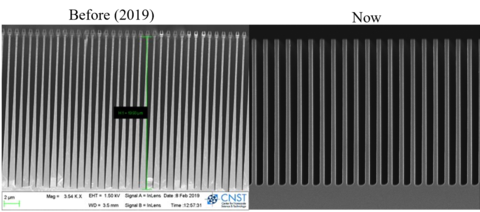
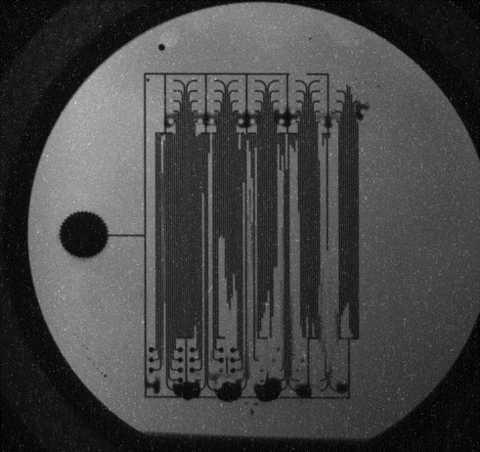
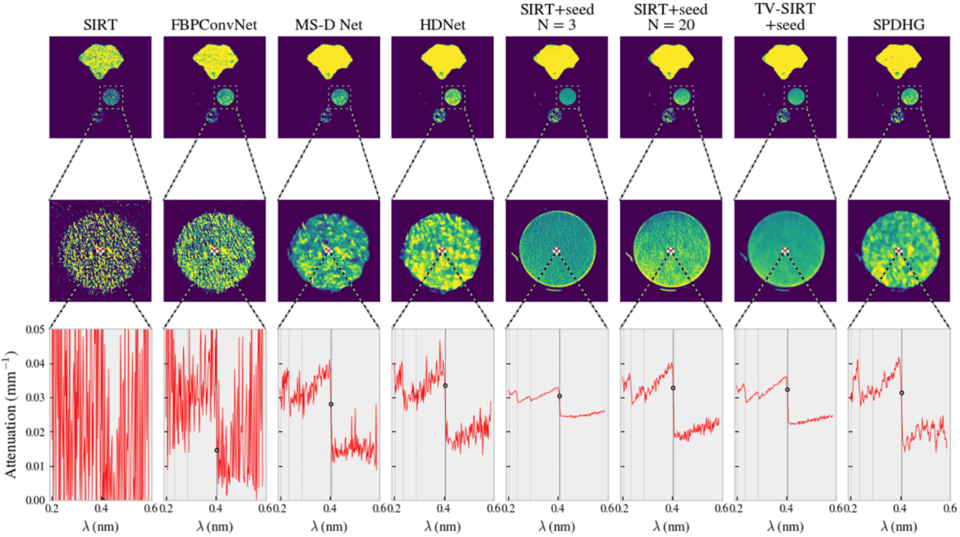
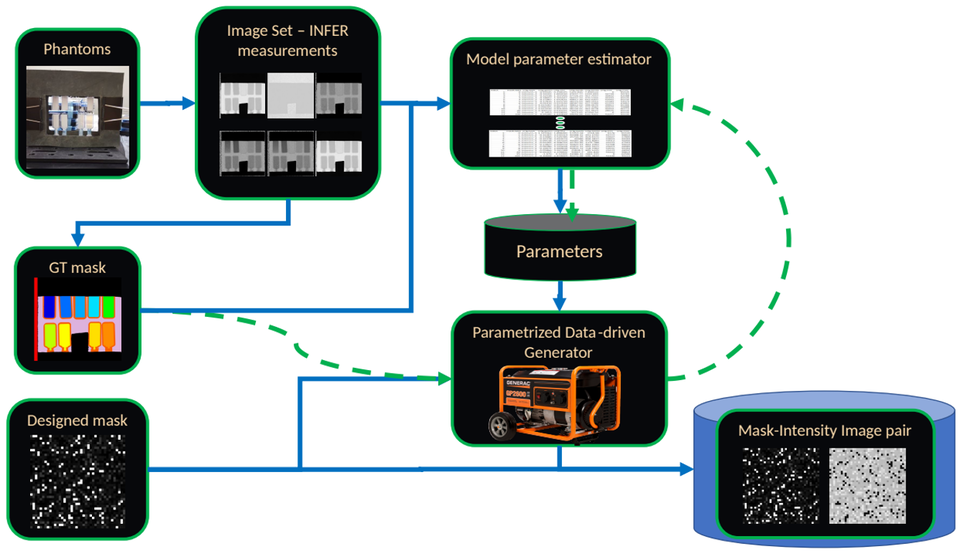
Ongoing efforts to fully realize INFER prototype
Due to the NCNR recovery efforts and neutron guide upgrade project, it is anticipated that the INFER prototypes will be fully developed on NG6 in 2027. To obtain microstructural details, requires multiple tomographic acquisitions at multiple ξ. We seek to obtain 100 ξ measurements over 3D in one day, requiring advances in data acquisition, neutron optical components, image reconstruction, and data analysis. The INFER collaboration seeks to further develop and deploy:
- The finest pitch (<700 nm) neutron phase gratings for measurement of Big-G
- Generation of >100 dark-field tomogram data sets per day
- Automatic fitting of 4D correlogram data sets
- Multi-scale data visualization tools
References
[1] D. A. Pushin et al., “Far-field interference of a neutron white beam and the applications to noninvasive phase-contrast imaging,” Phys. Rev. A, vol. 95, no. 4, 2017.
[2] D. Sarenac et al., “Three Phase-Grating Moiré Neutron Interferometer for Large Interferometer Area Applications,” Phys. Rev. Lett., vol. 120, no. 11, p. 113201, 2018.

